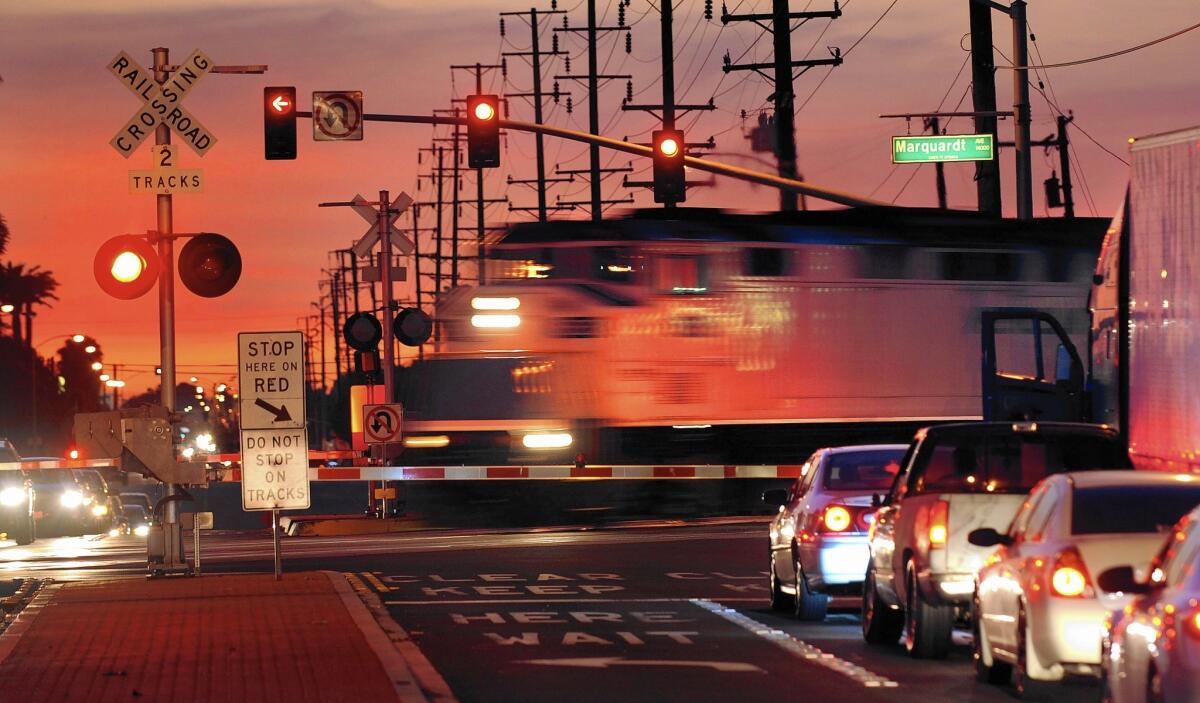Spending on rail crossing safety upgrades varies widely across Southland

When a Metrolink train slammed into an SUV on railroad tracks in Glendale a decade ago, the horrific chain reaction wreck prompted a major campaign to improve the safety and security of Southern California grade crossings.
Last week’s crash involving a commuter train and a pickup truck in Oxnard was a reminder that progress has been decidedly uneven. A patchwork of entities with varying levels of funding are responsible for street-level railroad crossings, and some have invested more than others in safety improvements.
Since the Glendale accident, transportation agencies from Ventura to Orange County and east through the Inland Empire have invested more than $3 billion in new gates and barriers, upgraded signage, safety arms and warning systems, as well as costly overpasses to completely separate trains and traffic.
A Times review of California’s most dangerous crossings showed that 36 of the top 100 intersections identified in the most recent federal data were in the five-county area. In the five years ending with 2013, 74 collisions were reported at those Southern California crossings and the trend was slightly upward, moving up and down in a range of 10 to 21 crashes a year.
The review also found notable differences in county-to-county efforts to correct problems at rail crossings identified as the most dangerous by federal regulators. The crossings, many of which are on track shared by passenger and freight railroads, are controlled by a mix of private companies and public agencies.
Orange County has spent about $1 billion on various combinations of improvements at 52 crossings it maintains. The upgrades include sophisticated systems to detect vehicles stopped on tracks and other warning system upgrades that researchers have found can reduce collisions at rail crossings. The county also has completed five new bridges to separate trains and vehicles, with five more now under construction.
By contrast, officials in Ventura County, where last week’s Metrolink crash occurred at a crossing with a record of deadly accidents, lack the special transportation tax revenue that voters in Orange and other local counties have approved. That means they have less money to leverage for state and federal grants to make major improvements.
Officials there have allocated about $18 million for safety upgrades at crossings in Moorpark and Simi Valley, but a planned overpass for the busy Rice Avenue crossing where last week’s accident occurred has languished for almost two decades.
“A $35-million grade separation is no small project for Ventura County,” said Darren Kettle, the executive director of the Ventura County Transportation Commission. “We do not have a dedicated funding stream.”
The differences can mean that train passengers, crews, pedestrians and motorists face varying risks in different parts of the same regional rail network, some experts said.
“Because Los Angeles and Orange counties are investing more in grade separations and rail crossing improvements, you are less likely to see an accident like what happened in Ventura County,” said Hasan Ikhrata, executive director of the Southern California Assn. of Governments, a regional planning agency.
The Los Angeles County Metropolitan Transportation Authority, which controls about 160 of Metrolink’s crossings, has contributed about $1 billion to various upgrade projects. One major effort is being made in the San Gabriel Valley along the Alameda Corridor East, a key freight route. Bridges have been added at 18 crossings, and other improvements have been made at 36 more.
In the San Fernando Valley, Metro officials are helping fund improvements to nine at-grade crossings on the L.A. County portion of Metrolink’s line that heads to Ventura County. The upgrades include street medians to better control traffic, so-called four-quad arms that lower and block all lanes on both sides of passing trains and separate sidewalk gates designed to keep pedestrians out of harm’s way.
Metro also is preparing to hire a consultant in the weeks ahead to analyze all its crossings and determine which are the most dangerous, factoring in previous crashes and near-misses, said Don Sepulveda, the agency’s executive officer for regional rail.
“Grade crossings are important to communities because in many cases, it’s their only contact with the railroad,” Sepulveda said.
Representatives for Union Pacific Railroad and BNSF Railways, the two private freight firms operating in Southern California, said they work closely with state and local officials. But ultimately government agencies decide what types of warning devices to install, they added. A Union Pacific spokesman said the company has reduced grade-crossing accident rates along its rights-of-way by 15% from 2003 to 2013.
Building overpasses and underpasses reduces traffic delays and effectively eliminates the risk of collisions between trains and vehicles. But at $20 million to $100 million each, depending on terrain, design and surrounding land values, only a relative handful of those are considered practical, officials say.
San Bernardino County, a major portal for freight trains bound for eastern states, has committed about $340 million for 10 grade separations. Neighboring Riverside County, also a freight train hub, has spent about $461 million since 2008 on various crossing improvements. But even with a transportation sales tax, the county has far more work to be done than money available. A plan to build overpasses at 31 high-priority crossings has had to be scaled back to 20, with five finished and eight under construction.
“Separating a grade crossing is a giant leap in expense, so you really have to look at the cost-benefit of it,” said David Ragland, the director of the Safe Transportation Education and Research Center at UC Berkeley. “An overpass is an effective solution for very, very heavy traffic roadways, but there are other ways too.”
For example, Ragland’s team found that intersections with no protection or improvements could attain a 98% reduction in collisions by installing four arms that block all street lanes when a train approaches. The accident reduction was 82% with just one arm on each side of the street in the direction cars are traveling.
A Times analysis of Federal Railroad Administration data shows most of the Los Angeles County collisions at rail crossings — about 68% — occur at locations with only the dual safety arms. Far fewer occurred at intersections equipped with the quad arms. Orange County reported only one collision between 2009 and 2013 where the four-way warning arms were installed, the data show.
Among other safety features being tried are electronic loops, embedded in crossing roadways, that detect a car trapped on tracks between safety arms. The system automatically opens a gate to clear a path for the vehicle to exit. Metrolink officials say the loops have been installed at close to a quarter of the 280 crossings it controls; Orange County has installed them at 18 locations.
“You are never done with safety. It is an evolving and changing dynamic,” said Darrell Johnson, the Orange County Transportation Authority’s chief executive officer. “We are looking for what the next changes might be.”
Ikhrata, the Southern California government association official, said $1 billion from California’s high-speed rail project has been earmarked for improvements to local rail lines in the years ahead. However, an additional $4.5 billion is needed for grade separations and safety improvements to rail crossings across the region.
One possible solution for some of the funding challenges could be a multi-county sales tax dedicated to the problem, he said.
Unfortunately, it often takes a tragedy to solve serious safety issues, he added.
“There have been many improvements since the Glendale crash,” Ikhrata said. “Much still needs to be done, but do we have the resources? The answer is no.”
More to Read
Sign up for Essential California
The most important California stories and recommendations in your inbox every morning.
You may occasionally receive promotional content from the Los Angeles Times.






